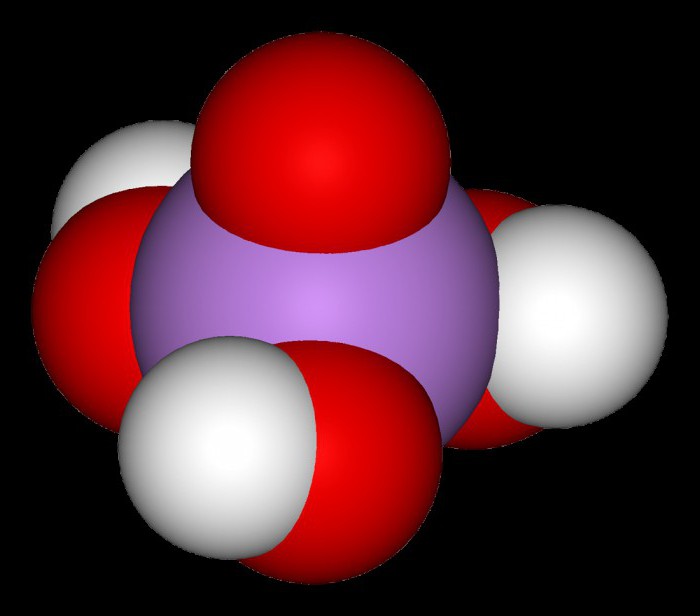The impact of various chemicals on the human body is ambiguous. Most of the known compounds are either neutral or play a positive role in human life. But there is a group of substances that pose a serious threat to health. They are divided into several classes. Arsenic acid, considered in this article, is one of such toxic chemical compounds. According to the currently accepted classification, it is in the second class of increased danger, along with chloroform, lead and lithium compounds. We study the properties of arsenic acid in more detail.
The structure of the molecule and the state of aggregation of matter
This compound has a crystalline structure under ordinary conditions. Being a tribasic, arsenic acid, the formula of which is H 3 AsO 4 , has both medium and acid salts. For example, potassium hydrogen arsenate - K 2 HAsO 4 , sodium dihydroarsenate - NaH 2 AsO 4 , lithium arsenate - Li 3 AsO 4 . By calcining arsenic acid, arsenic hemipentoxide, called arsenic anhydride, is obtained. Its white transparent crystals form a vitreous mass, poorly soluble in water.
Dissociation
H3AsO 4 , along with formic acid and lead hydroxide, is a moderately weak electrolyte. So, in the ionization table of the most important acids, ortho arsenic acid has three dissociation constants: 5.6 x 10 -3 , 1.5 x 10 -7 and 3, 89 x 10 -12 . These indicators quantitatively characterize the strength of the acid. In accordance with the dissociation constants, in the series of inorganic acids, H 3 AsO 4 occupies a position between chromic and antimony acids. Russian experimental chemists A.L. and I.L. Agafonovs formulated a mathematical expression in which the temperature dependence of the first and second arsenic acid dissociation constants was derived in the range from 0 ° C to 50 ° C.
Chemical Features
The oxidation state of the arsenic atom, which is part of the acid molecule, is +5. This suggests the fact that the compound itself in chemical reactions with other substances exhibits oxidizing properties. So, in its interaction with potassium iodide, which acts as a reducing agent, in an acidic environment, among the reaction products, we will find arsenic acid H 3 AsO 3 . Recall that arsenic acid, the formula of which is H 3 AsO 4, is tribasic, which means that in reactions with alkalis or insoluble bases it can give three types of salts: medium, hydro- and dihydroarsenates. A qualitative reaction to the AsO 4 3- ion in analytical chemistry is the interaction of arsenic acid itself or its salts with soluble silver salts, for example, with nitrate. As a result, we observe the precipitation of Ag 3 AsO 4 coffee color.
Arsenic acid iodometric method
In analytical chemistry, an important task is the detection of chemical compounds in the studied solutions. Arsenic acid, the chemical properties of which we examined earlier, can be detected by the iodometric micrometric method. The same volume of 4N is added to 1 ml of its solution. hydrochloric acid solution and 1 ml of 4% potassium iodide solution. Arsenic sesquioxide As 2 O 3 is formed, the mass of which, with strict adherence to the quantitative volumes of reagents, is always the same and equal to 0.5746 mg.
Oxidative ability of arsenic acid
As is known, H 3 AsO 4, like phosphoric acid, is an electrolyte of medium strength. Its white transparent crystals melt in air and have a composition of 2H 3 AsO 4 x H 2 O. Its salts formed by alkali metals (both medium and acidic) in aqueous solutions have a pH above 7. Arsenates of lithium, potassium, sodium and ammonium well soluble in water, and the remaining middle salts do not dissolve in it. Arsenic acid is a good oxidizing agent. In redox reactions, it is reduced to arsenic acid or arsine.
H 3 AsO 4 + 2e + 2H + = H 3 AsO 3 + H 2 O
H 3 AsO 4 + 8e + 8H + = AsH 3 + 4H 2 O
In addition, arsenic acid easily oxidizes various metals, sulfite and iodide acids, as well as hydrogen sulfide.
Getting arsenic acid
Under laboratory conditions, H 3 AsO 4 can be obtained by reacting arsenic sesquioxide with nitrate acid when heated. Trivalent nitric oxide and H 3 AsO 4 are detected in the products . Another method of preparation is dissolution of arsenic oxide in water . Often, simultaneous oxidation and hydrolysis of trialkylarsenites using a solution of hydrogen peroxide heated to 50 ° C is used. At the same time, water and alcohol are removed from the reaction mixture. Then the solution is evaporated and get arsenic acid of high purity. In nature, the raw materials for the production of arsenic acid are minerals: arsenolite and arsenopyrite, whose deposits are rich in the Chelyabinsk and Chita regions of the Russian Federation.
H3AsO4 Application
Given the fact that ortho arsenic acid is one of the strongest poisons. Its use in industry and everyday life is limited. Arsenates are more common salts, whose toxicity is much lower than that of H 3 AsO 4. So, in the woodworking industry, together with zinc sulfate and pentachlorophenol sodium salt, arsenic acid is used to process wood. Such a method minimizes losses from cellulose destruction by fungal infections and larvae of woodworm beetles. In medicine, H 3 AsO 4 is used as part of the Atoxil preparation for the treatment of protozoal infections, such as giardiasis, balantidiasis, isosporosis.

It should be noted that the infection rate of the population with these infections has recently risen sharply. There are several reasons - for example, infection through food containing spores of protozoa, through insect bites or sexually. Arsenic acid is used as a starting material in optical glass manufacturing processes, as well as in electrical engineering. Derived H 3 AsO 4 - its sodium salt, is successfully used in dermatology and phthisiology. Arsenic compounds are used in dentistry (arsenic paste) as a drug used to reduce the pain sensitivity of an inflamed nerve when it is removed from the dental canal.
The effect of acid on the human body
As mentioned earlier, H 3 AsO 4 is included in the second class of increased hazard - highly hazardous substances. The dosage of both the acid itself and its salts is considered fatal in the range of 15 to 150 mg per kilogram of human body weight. Along with the general toxic effect, arsenic acid causes necrosis of the skin and mucous membranes of the internal organs: lungs, stomach, intestines.

In the laboratory, when conducting experiments with arsenates and H 3 AsO 4 , the use of protective gloves is mandatory, and the experiments themselves are carried out under the hood. In case of intoxication at the level of the cell, its enzymatic system is disturbed, as enzymes are inactivated. In the human body, arsenate poisoning leads to paresis and even paralysis. In oncology, during chemotherapy with non-compliance with the dosing regimen, cases of poisoning with myarsenol and novarsenol are recorded. First aid for poisoning with arsenic acid salts is to immediately rinse the stomach (for example, with a unithiol solution or silica preparations).

To prevent acute renal failure, a hemodialysis procedure is prescribed. As an antidote, in addition to a 5% solution of unitiol, you can use Strizhevsky's antidote. Before the emergency ambulance arrives at home, a solution of citric acid can be used to reduce the level of intoxication, then induce vomiting and rinse the stomach. All medical measures must be carried out in compliance with strict bed rest under the supervision of a doctor.